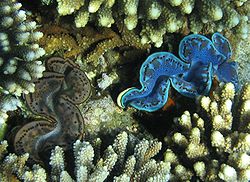Clam
A clam is a type of shellfish. Clams can be found in saltwater and freshwater. This is a common usage term, and so includes quite a variety of shellfish. Clams are a fairly common form of bivalve, therefore making it part of the phylum Mollusc. There are many clams in the ocean, but some can also be found in some lakes, streams, and rivers.
The word 'clam' is often applied to those that are edible and live most of their lives halfway buried in the seafloor. Clams have two shells of equal size connected by two aductor muscles and have a powerful burrowing foot.[1]
Clams for cooking do not live attached to rocks (whereas oysters and mussels do). Clams are often got by digging and cooked and served as clam chowder. They may be found on menus in restaurants that serve seafood.
Clams eat plankton, and are eaten by small sharks and squid. Clams have a burrowing foot that they use to dig down into the sand or mud to hide.
The shell has three layers. The top one is called mother-of-pearl because it is a coating of pearl material.
A living freshwater clam can work like a filter in fish tanks to keep the water clean.
Life span
Some clams have life cycles of only one year, while at least one may be over 500 years old.[2] All clams have two calcareous shells or valves joined near a hinge with a flexible ligament, and all are filter feeders.
Clam Media
A clam shell (species Spisula solidissima) at Sandy Hook, New Jersey
Clams simmering in a white wine sauce
One of the world's largest clam fossils (187 cm), a Sphenoceramus steenstrupi specimen from Greenland in the Geological Museum in Copenhagen.
References
- ↑ "Clam". Encyclopædia Britannica. Encyclopædia Britannica. 2016.
- ↑ Danielle Elliot (14 November 2013). "Ming the Clam, World's Oldest Animal, Was Actually 507 Years Old". CBS News. Archived from the original on 20 November 2013. Retrieved 15 November 2013.
Other websites
![]() Media related to Clam at Wikimedia Commons
Media related to Clam at Wikimedia Commons





